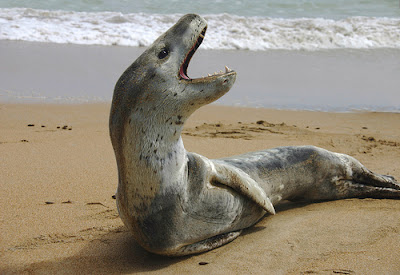Whether you are a fan of the theory or not, the
idea that a pinniped species (seal, sea lion or fur seal) could have evolved a
long neck and be responsible for many sightings of lake monsters and sea
serpents, is an attractive alternative to a surviving plesiosaur.
Theoretical North Atlantic Otariid ( Copyright Cornes based on
Steller Sea Lion photo by Doug Forsell)
However from its inception by Oudemans, to its
refashioning by Heuvelmans and subsequent reinvention by Costello the mechanics
of its morphology have changed dramatically. From a leviathan pinniped with a
tail envisioned by Ouedemans approaching the size of a blue whale, to the
smaller long neck and merhorse of Heuvelmans, as well as the much
more modest size of 30ft suggested by Costello. Yet despite these common sense
revisions no such conspicuous animal has been discovered or documented by science
making its elusiveness suspicious.
In more modern times the theory has been strengthened
by the historical account of a long necked pinniped catalogued by Grew and
Parsons (see Parson Seal) and the paleontological discovery of two archaic true
seals or phocidae; Acrophoca longirostris
and Piscophoca Pacifica which appear
to have evolved a minor lengthening of their cervical vertebrae. The
possibility that new pinniped species await discovery has also been suggested
in an innovative scientific research paper by Naish et al.
Sir George Grey Special Collections, Auckland Libraries, AWNS-19181017-37-1
This has created a bit of a cryptozoological
conundrum. On the one hand there are historical reports of sea serpents and
lake monsters with very pinniped-like features, from the bunyip of Australia, the horse
eels of Connemara, the nykur and Skrimsl of Iceland and Pal Rai Yuk of Alaska. The Mackintosh
Bell and Filey sightings, the mysterious denizens of Lake Storsjo and Loch Ness
among others.
On the other hand there is a complete lack of
physical evidence for such cosmopolitan animals.
So could they exist? Well maybe in theoretical terms yes, possibly!
Although we have uncovered many historical
inaccuracies and alternative explanations for some of the strongest historical
evidence we have also found tantalising evidence that seems to support the idea
albeit with some caveats. If such an animal does exist it is unlikely to be
that different from extant species, most probably a novel species of sea lion
or fur seal or perhaps even a hybrid form. Predatory and environmental factors
could have theoretically caused a shift in morphology and a sea lion or fur seal
in the North Atlantic where there has never been such a species might certainly
explain some of the historical evidence.
Hypothesis
A previously unidentified sea lion or fur seal colonised the North Atlantic. Alternatively an extant species became displaced, possibly due to some past climatic or ecological catastrophe (there have been a few). Finding itself in competition with already existing indigenous species it adapted its lifestyle; foraging inland following spawning fish or fish runs and perhaps using lakes to exploit food resources all of which are current traits of extant pinnipeds to a certain degree. The development of a more elongated neck would allow easier predation and this could have occurred quite quickly if we allow for hyperspeed evolution.
In addition a sea lion or fur seal would have visible external ears (which might look like horns), the male would have a mane, which on a longer neck may be more prominent and such an animal inhabiting the North Atlantic for a few thousand years might also share similarities with the water horse of Northern Europe.
Hypothesis
A previously unidentified sea lion or fur seal colonised the North Atlantic. Alternatively an extant species became displaced, possibly due to some past climatic or ecological catastrophe (there have been a few). Finding itself in competition with already existing indigenous species it adapted its lifestyle; foraging inland following spawning fish or fish runs and perhaps using lakes to exploit food resources all of which are current traits of extant pinnipeds to a certain degree. The development of a more elongated neck would allow easier predation and this could have occurred quite quickly if we allow for hyperspeed evolution.
In addition a sea lion or fur seal would have visible external ears (which might look like horns), the male would have a mane, which on a longer neck may be more prominent and such an animal inhabiting the North Atlantic for a few thousand years might also share similarities with the water horse of Northern Europe.
To be continued....
Sea lions on a beach (Paul Chinn)
Recuento de mamífero en la Península Potter (Armando C. L. Genta), Wikimedia







This comment has been removed by the author.
ReplyDelete